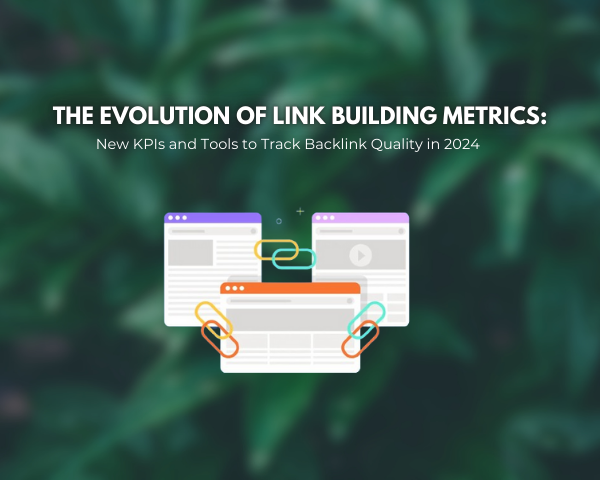New Link Building Metrics: KPIs and Tools for 2024
In the dynamic world of SEO, link building remains a cornerstone of successful online visibility. As we move into 2024, the metrics and tools used to assess the quality and impact of backlinks have evolved. Understanding these new KPIs and leveraging the right tools can significantly enhance your link building strategy. This article explores the latest developments in link building metrics, offering insights into the KPIs that matter most and the tools that can help track backlink quality effectively.
The Importance of Evolving Link Building Metrics
Link building has always been about more than just quantity. Quality, relevance, and the authority of backlinks play a crucial role in determining how a website ranks in search engine results pages (SERPs). With search engine algorithms constantly evolving, the metrics used to measure the effectiveness of link building efforts must also adapt. New link building metrics are essential for accurately gauging the impact of backlinks and refining strategies to ensure they align with current SEO best practices.
Key Performance Indicators (KPIs) for Link Building in 2024
1. Domain Authority and Page Authority
Domain Authority (DA) and Page Authority (PA) remain vital metrics in 2024. Developed by Moz, these metrics predict how well a website or specific page will rank on SERPs. High DA and PA scores indicate that a website is considered trustworthy and authoritative, making links from such sites more valuable.
- Domain Authority measures the overall strength of a website, taking into account factors like the number and quality of backlinks.
- Page Authority focuses on the ranking strength of individual pages, which can vary significantly even within a single domain.
2. Trust Flow and Citation Flow
Introduced by Majestic, Trust Flow and Citation Flow are critical metrics for evaluating backlink quality:
- Trust Flow assesses the quality of links pointing to a site, indicating how trustworthy a website is based on its backlink profile.
- Citation Flow measures the quantity of links pointing to a website, without necessarily assessing their quality.
A high Trust Flow with a relatively high Citation Flow suggests a healthy balance between the number and quality of backlinks, which is a positive indicator for SEO performance.
3. Relevance and Contextual Relevance
In 2024, the relevance of backlinks is more important than ever. Search engines prioritize links that are contextually relevant to the content they are embedded in. This means that obtaining backlinks from sites within the same industry or niche, where the link makes sense contextually, is crucial.
- Contextual relevance ensures that backlinks not only pass link juice but also resonate with the target audience, providing additional value.
4. Anchor Text Diversity
The text used to hyperlink to your website, known as anchor text, plays a significant role in link building. Search engines analyze anchor text to understand the relevance of the linked page. In 2024, a balanced approach to anchor text is essential:
- Exact-match anchor text can indicate relevance but should be used sparingly to avoid penalties for over-optimization.
- Branded anchor text, generic terms, and natural language variations should be incorporated to maintain a natural backlink profile.
5. Link Velocity
Link velocity refers to the rate at which a website acquires backlinks. An unnatural spike in link acquisition can trigger search engine penalties, as it may indicate manipulative link-building practices. Monitoring and maintaining a steady, organic link velocity is crucial for sustained SEO success.
Tools to Track and Measure Backlink Quality
1. Ahrefs
Ahrefs is a leading tool for comprehensive backlink analysis. It provides insights into:
- Backlink profiles with detailed reports on referring domains, anchor text distribution, and link growth over time.
- Organic search traffic and keyword rankings, allowing for a direct correlation between link-building efforts and search performance.
- Domain Rating (DR), a metric that indicates the strength of a website’s backlink profile compared to others in the database.
2. SEMrush
SEMrush offers robust tools for monitoring backlinks and competitor analysis. It includes features such as:
- Backlink Audit, which evaluates the quality of backlinks and identifies potentially harmful links.
- Link Building Tool, which helps in discovering new link opportunities based on targeted keywords and competitor strategies.
- Authority Score, which combines multiple SEO metrics to assess the overall quality and strength of a website.
3. Moz Link Explorer
Moz Link Explorer is designed to provide in-depth insights into link building with metrics like DA and PA. It also offers:
- Spam Score, which helps identify potentially harmful backlinks that could negatively impact SEO.
- Link Intersect, a tool to find sites that link to competitors but not to you, highlighting potential backlink opportunities.
4. Majestic SEO
Majestic focuses on Trust Flow and Citation Flow, providing a detailed view of link quality and site authority. It features:
- Site Explorer, which offers a comprehensive analysis of backlink profiles.
- Topical Trust Flow, a metric that shows the thematic relevance of backlinks, helping to ensure that links come from relevant and authoritative sources.
Enhancing Your Link Building Strategy with New Metrics
As the SEO landscape continues to evolve, staying updated with the latest link building metrics and using the right tools is crucial. By focusing on these new KPIs, marketers can more accurately measure the quality and impact of their backlinks, ensuring that their strategies are aligned with current SEO best practices. Leveraging tools like Ahrefs, SEMrush, Moz, and Majestic can provide the insights needed to refine link building efforts, ultimately driving better search engine rankings and increased organic traffic.
Embracing these new metrics and tools not only helps in tracking and measuring backlink quality but also provides a roadmap for continuous improvement. By understanding what works and what doesn’t, marketers can make data-driven decisions that enhance their link building strategies, ensuring long-term success in the competitive digital landscape of 2024.


